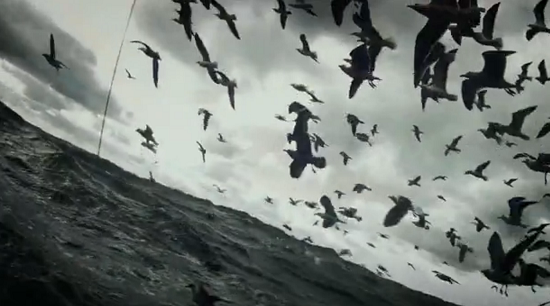There’s a dichotomy at the heart of Lucien Castaing-Taylor and Véréna Paravel’s Leviathan; something that serves as a reflection of the state of contemporary cinema and its ever fluxing spaces of presentation and consumption. The dichotomy goes something like this: how can a film that so relentlessly messes with the ‘traditional language’ of cinema be so perfectly suited to, and perhaps even reliant upon, the cinema environment?
Two things struck me whilst watching Leviathan. Firstly, that experimental film has embraced the possibility for shifts in stylistics and aesthetics – enabled by an ever-widening technological toolbox available at the point of production – more than mainstream produce. Secondly, such contemporary experimental practices are increasingly subjected to a variety of different presentation spaces: galleries and expanded cinema contexts and so on. Leviathan provides an interesting case- an example of a work embracing that technological toolbox, though very much enhanced by a presentation within a traditional cinematic context.
Harvard University’s Sensory Ethnographic Lab (SEL) has received considerable attention across the festival circuit this year. SEL’s work has been the focus of two retrospectives, alongside screenings of new material – Manakamana, (2013, Spray/Velez) and Yumen, (2013, Xu, Huang, Sniadecki) – at both the Montreal International Documentary Festival and Vienna International Film Festival. The Lab’s Director, Castaing-Taylor, and Faculty Professor, Paravel, are the collaborators on Leviathan, the work that qualifies as their out-and-out ‘hit’.
The film is a nearly wordless examination of North American industrial fishing practices, focusing on one vessel off the Boston coast. The word ‘examination’ seemingly implies a probing or study of a subject, mediated by a director keen on propounding a particular world-view. Leviathan is the antithesis of this. Using dozens of miniature GoPro cameras, dispersed around the shipping vessel, Castaing-Taylor and Paravel aim to fashion a film that sits between a simple framing of the human labour integral to industrial fishing and pure painterly abstraction. At times the film could be seen as a descendent from Structural filmmaking practices of 60s and 70s; the cameras fixed to the body of the ship echo the predetermined structuring integral to that movement. It then flits into a more observational mode, showing the hardships of life at sea. Quickly though, disorientation and abstraction rule once again- the fixed cameras plow through the ocean, or mingle with fish guts, sliding around, unchained and unmanned, on the ship’s deck.
Yet, though never propounding a particular world-view or style, Leviathan seems to insist on the theatre as its ideal site of consumption. Though never working within a narrative frame, the film – as its title implies – needs to be viewed as a monolithic whole. It is a work most concerned with two things: its transitions from painterly abstraction to more traditional observation, and shifts in size and scale. Rarely has a film so non-traditionally cinematic so relentlessly insisted on a theatrical viewing. Get to the cinema, I urge you.


